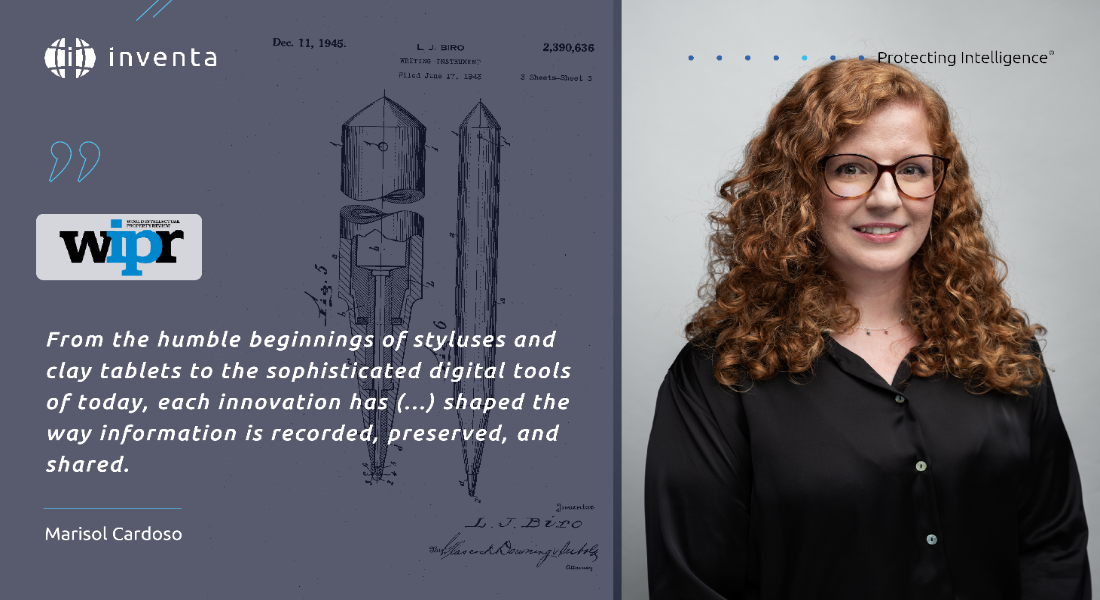
From quills to qwerty: the evolution of writing through patents
The development of writing tools over time reflects the evolution of human communication and technology and further demonstrates how advancements in materials and digital innovation have transformed the way we record and share information.
It is believed that writing originated in only one location—Sumer, southern Mesopotamia (around 3500 BCE)—and later spread across the world via cultural diffusion. The Sumerians used a stylus made of reed to inscribe cuneiform on wet clay tablets, which were then baked to preserve the writing for recording of transactions, laws, and stories.
By the same time, ancient Egyptians used hieroglyphs for inscriptions carved mostly on the walls of temples and tombs. Hieroglyphs, which means ‘sacred carving’, were created for eternity, either for the gods or for the afterlife.
The use of papyrus leaves for writing only appeared a few centuries later. In 3000 BCE, ancient Chinese civilisation’s development of ink and brushes made from animal hair facilitated more detailed and artistic forms of writing on silk and bamboo strips, until the Greeks and Romans’ use of parchment and quills (around 500 BCE) enabled more portable and durable writing.
In the Middle Ages, the quill pen, made from bird feathers, became the primary writing instrument for scribes and was used on parchment (animal skin) or vellum.
Pen innovation
But it is only when the early modern writing tools appeared that the history of writing meets the history of patents.
Metal nibs (part of the quill or pen which comes into contact with the writing surface to deposit ink) appeared to replace quills as they were more durable and could be mass-produced. Even though writing instruments with metal nibs date all the way back to ancient Egypt, a metal pen point was only patented in 1808 by English inventor Bryan Donkin.
The oldest patent known for a fountain pen is dated 1827, when Petrache Poenaru, a Romanian mathematician, patented a fountain pen in France that used a reservoir of ink, eliminating the need for constant dipping.
By the late 19th century, improvements made fountain pens widely popular for their convenience and Lewis Waterman, inventor and founder of Waterman Pen Company (a luxury pen brand), patented the first reliable fountain pen after losing a big sale with a client due to a leaking problem of the pen: an excessive discharge of ink when in use. In the following years, several Waterman patents were filed to cover fountain pens with different kinds of innovations.
The ballpoint writing apparatus created by John Loud in 1888 is considered the first ballpoint pen. The patent claims a pen with a spheroidal marking point capable of revolving in all directions for applying ink to rough surfaces, including wool and coarse wrapping paper.
But it was László Jozsef Bíro who invented the modern ballpoint pens, which relied on gravity to draw ink towards the tip, requiring the user to hold the pen perfectly upright in order to write.
Hymen Lipman is credited with registering the first patent for a pencil with an attached eraser in 1858. A few years later, Lipman sold his patent to Joseph Reckendorfer, who went on to sue the pencil manufacturer Faber for infringement.
However, the result did not come as expected: the patent was declared invalid by the United States Supreme Court because the invention was actually a combination of two already known things with no new use.
Pencil technology, however, continued to develop: Danish company Sprout is the assignee of a patent for a plantable pencil wherein a capsule with one or more seeds is disposed at the non-writing end of the pencil. When the writing instrument is exhausted, the capsule may be planted into moist soil, which may cause the capsule to degrade and release the seeds, allowing plants to grow.
In 2011, Apple patented the first generation of its ‘Apple Pencil’, an intelligent stylus which included multiple sensors to sense and transmit information to a corresponding touch-sensitive device. There are now four generations of the Apple Pencil, which are not only used for navigating through the operating system, but also to allow precision writing, sketching, and drawing.
Mechanical and digital writing
When it comes to mechanisation and consequently the revolution in speed and legibility of writing, the first practical typewriter dates from 1868 and had its origin in a printing machine designed two years earlier by Christopher Latham Sholes to assist with printing page numbers in books. Carlos Glidden became interested in the device and suggested that it might be adapted to print alphabetical characters.
A few years later, the patent was licensed and production started, but the action of the type bars was very sluggish and they tended to jam. To fix this problem, Sholes obtained a list of the most common letters used in English, and rearranged his keyboard from an alphabetic arrangement to one in which the most common pairs of letters were spread fairly far apart on the keyboard.
This new arrangement was named the Sholes QWERTY keyboard and allows the operator to write faster than a person writing by hand. Typing efficiency was further enhanced by the introduction of electric typewriters in 1892, invented and patented by George Blickensderfer.
The advent of personal computers and word processors in the 1970s marked a shift to digital writing, allowing for easy editing, formatting, and storing of text. This development transformed writing into a more flexible and efficient process, enhancing communication, collaboration, and information management.
Technologies like voice-to-text and AI-powered writing assistants emerged in the 2010s, offering new methods of text input. These innovations have made writing more accessible and efficient, breaking down barriers for those with disabilities and streamlining the writing process for all users.
Although these technologies are of great value to the evolution of writing, it is important to note that software and computer programs, as such, are excluded from patent protection under the European Patent Convention.
The evolution of writing tools reflects humanity’s quest for more efficient, durable, and convenient ways to record and disseminate information. From the humble beginnings of styluses and clay tablets to the sophisticated digital tools of today, each innovation has not only improved the efficiency and accessibility of writing but has shaped the way information is recorded, preserved, and shared.
This is a co-published article, which was originally published in the World Intellectual Property Review (WIPR).
Currency Info
Final charges will be made in USD.
Currency conversion is for information purposes only and accuracy is not guaranteed. Overseas customers are encouraged to contact their bank or credit card provider for details on any additional fees these institutions may include for currency conversion.
- USD 312.389 NGN
Territory List
There are no results for your search.
- Africa
- Algeria
- Angola
- Benin
- Botswana
- Burkina Faso
- Burundi
- Cameroon
- Cape Verde
- Central African Republic
- Chad
- Comoros
- Congo (Republic)
- Côte d'Ivoire
- Democratic Republic of the Congo
- Djibouti
- Egypt
- Equatorial Guinea
- Eritrea
- Eswatini (Swaziland)
- Ethiopia
- Gabon
- Gambia
- Ghana
- Guinea
- Guinea-Bissau
- Kenya
- Lesotho
- Liberia
- Libya
- Madagascar
- Malawi
- Mali
- Mauritania
- Mauritius
- Mayotte
- Morocco
- Mozambique
- Namibia
- Niger
- Nigeria
- Réunion
- Rwanda
- Sao Tome and Principe
- Senegal
- Seychelles
- Sierra Leone
- Somalia
- South Africa
- South Sudan
- Sudan
- Tanzania (mainland)
- Togo
- Tunisia
- Uganda
- Western Sahara
- Zambia
- Zanzibar
- Zimbabwe
- Africa (OAPI)
- Africa (ARIPO)
- Other
- East Timor
- Macao
- Maldives
- Portugal
- European Patent (EPO)
- European Union Trademark (EUTM)
- International Trademark (Madrid System)
- Patent Cooperation Treaty (PCT)




